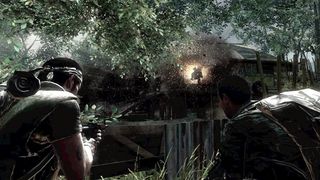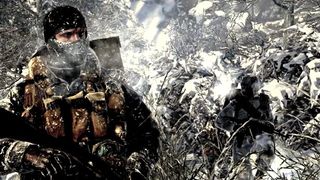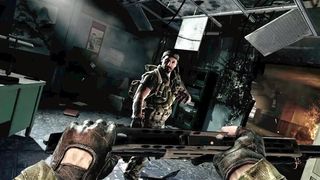With the Infinity Ward ranks in disarray, Activision has seen fit to promote its most trusted platoon to the frontlines. Can Call of Duty: Black Ops turn the emerging battle for wartime supremacy on its axis? And, more pertinently, how does one follow Modern Warfare 2? There goes the fear. Talk to developers Treyarch about pressure and they respond with how it is “welcomed”; “embraced” even. To the outsider looking in, it doesn’t look like an outfit with the weight of the world on its shoulders. It looks like one that’s ready to rewrite history.

Despite Treyarch’s cool exterior, however, there’s no question that Black Ops will be a watershed moment for the Santa Monica-based studio. The tumultuous events at Infinity Ward (which has seen a sizeable exodus of top creative talent in acrimonious circumstances) has propelled Treyarch (previously known as Activision’s ‘other’ Call of Duty specialist) right into the frontline of public visibility – right into the line of fire, if you will. If Black Ops fails to vault over the ludicrously high bar set by Modern Warfare, then does Call of Duty, as a triple-A franchise, even have a future? It’s do or die. The battle lines have been drawn.
It is unfair to continuously drag Infinity Ward’s woes into the equation, however. Activision had begun unscrewing the suppressors that had drowned out Treyarch’s fire long before Modern Warfare 2 reached the shops. Prior to Black Ops, Treyarch was seen as the workhorse in Activision’s stable, turning around Call of Duty games with incredibly tight deadlines, while simultaneously working on projects such as Spider-Man 3 and Quantum of Solace. This changed after the critical success of 2008’s World at War, which convinced Activision to re-purpose Treyarch as a pedigree studio. “In 2008, we had three separate teams working on three separate games,” explains Community Manager Josh Olin. “Now, the entire studio is focused on Call of Duty. However, they are still broken up primarily into three autonomous units: Single-player, Multiplayer and Co-op. This results in familiar team structures, but each component of Black Ops has many more resources and personnel assigned to each.”

The difference this extra breathing space makes to the in-game quality cannot be underestimated, as Treyarch’s Studio Head Mark Lamia recalls: “We completed this level called the Slaughterhouse at the tail end of last year. After looking at it, I had to tell this group of people who had worked so hard on it for months that it was good, but not good enough; that we were going to revisit the entire thing. The design was good, but I didn’t feel it had the level of emotional attachment I wanted it to have. In previous years, with deadlines as they were, we didn’t have that option – we’d have to leave it as it was. But we don’t have to now, with where we’re at, with where we can afford to be – and what we should be.”
Tales of scrapped levels can quickly mutate into visions of upturned tables and beetroot-faced execs if left unchecked; Lamia suggests however that all the pressure on the studio is self-inflicted. “There has never been an email from Activision saying ‘you guys have to step it up’. All the pressure has come from within as we strive to push forward. Call of Duty has to prove itself again with every release – all top gaming brands do.”

Of course, there is little doubt that with an expanded team, Treyarch will be able to come up with the goods in terms of making a balanced, action-packed shooter – with two full Call of Duty games already under its belt, there are no other developers out there so finely attuned to what the series is all about. Of more interest is how they approach a time period of their own choosing after living off World War II scraps for so long. “We still think World War II is awesome,” says Lamia, putting a hell of a lot of trust in us to not quote him out of context. “But a new setting inspires new ideas and new stories that we can tell in Call of Duty’s cinematic style.”
The setting in question is the Cold War period, a time in history that Olin describes as a “fertile” ground for game-making. “Not many games have covered this time period, and none to my recollection have covered the Black Ops teams in the manner we are. During the Cold War, there were many hot conflicts and deniable operations taking place by both superpowers that nobody knew about. These missions were often times way behind enemy lines, in the face of what would appear to be insurmountable odds. That’s just crying out ‘Call of Duty!’”

He’s right, you know. Another man who agrees is Major John Plaster, a highly decorated Vietnam veteran who served in the Studies & Observations Group (SOG), leading recon teams in Vietnam, Laos and Cambodia. Plaster, Lamia tells us, was already familiar with Call of Duty, having seen his grandson play World at War (the Zombies mode, since we can tell you’re curious), and was eager to lend his expertise to Treyarch’s team.
“Listening to his experiences was very sobering,” recalls Lamia. “Hearing about what he did, what the people who didn’t make it back did... it was powerful stuff.” Powerful stuff indeed – so it’s time for the old chestnut to be wheeled out: how does he feel about his experiences being turned into idle entertainment? “He says that he gets why people would want to play it – it’s exciting material,” replies Lamia. “If it inspires the player to learn about the conflict, then he sees that as a good thing.” There’s an element of personal gain for the veteran, too. “Until now, he wasn’t able to talk about the things that have happened. He faced death countless times and no one knew about it. This is a way for him to be recognized for all the things that he’s done.”

“Working in this fresh new timeframe,” adds Olin, “has afforded us the opportunities to make some really great gameplay mechanics that the Call of Duty player is really going to love – such as changeable ammunition types, unconventional weaponry. What we learned from veterans like Major John Plaster played perfectly into the core concepts of great FPS action shooters. One story he told us was about the armories a SOG team would walk into. They literally could pick and choose anything they wanted for their load-out – whatever the mission required. They were the experts; nobody was going to question them. At Treyarch, we’re scratching our heads thinking ‘Hmmm, this sounds exactly [the sort of thing that] gamers would love!’”
